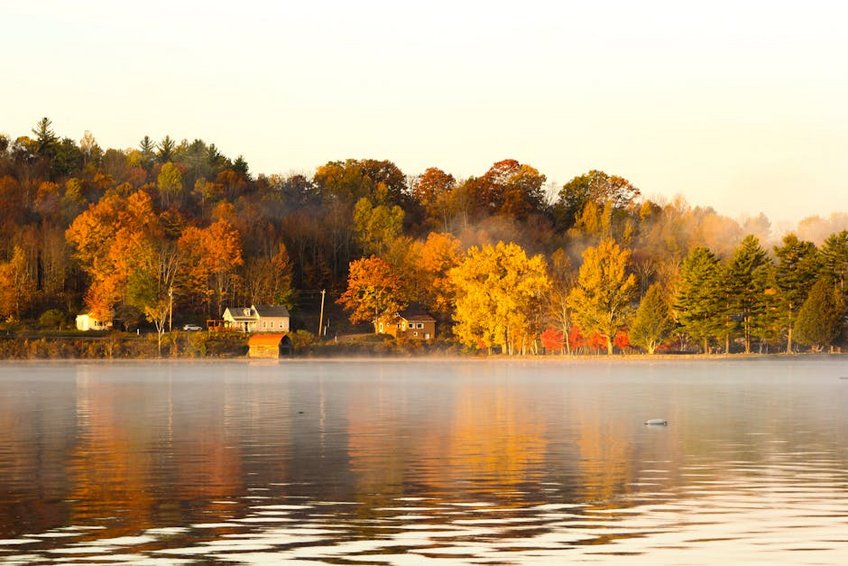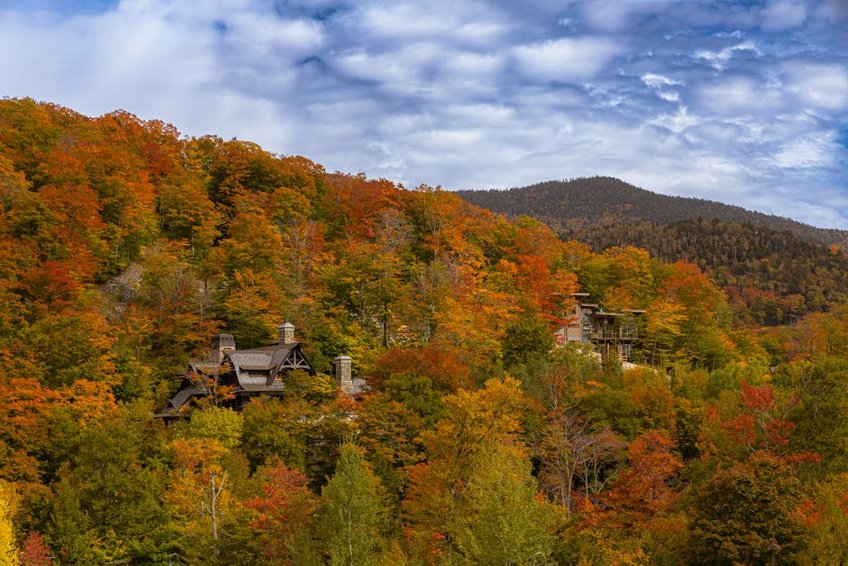Vermont Fall Foliage: Your Ultimate Guide to Autumn’s Golden Paradise
Experiencing Vermont fall foliage is like stepping into a living painting where nature shows off its most vibrant colors. As someone who’s chased autumn colors across multiple continents, I can confidently say that Vermont offers one of the most spectacular displays on Earth. The transformation begins in early September in the northern regions and gradually sweeps southward, creating a wave of crimson, gold, and orange that blankets the entire state. What makes Vermont fall foliage particularly special is the diversity of tree species – sugar maples, red maples, oaks, and birches – each contributing their unique hues to this natural masterpiece. The crisp mountain air, farm-fresh apple cider, and the sound of leaves crunching underfoot create an sensory experience you’ll remember for years. Whether you’re a photographer seeking that perfect shot or simply someone who appreciates nature’s beauty, Vermont’s autumn transformation deserves a spot on your bucket list.
Vermont Fall Foliage Essential Information – When Nature Puts On Its Best Show
Understanding the science and timing behind Vermont fall foliage will significantly enhance your experience. The color change occurs as trees prepare for winter, shutting down chlorophyll production and revealing the carotenoids and anthocyanins that create those stunning yellows, oranges, and reds. Vermont’s unique combination of elevation variations, soil types, and tree diversity creates a longer and more varied foliage season than most places. The northern regions around Jay Peak and Newport typically peak around late September, while the southern areas near Bennington and Brattleboro might not reach peak color until mid-October. Temperature and moisture play crucial roles too – cool nights and sunny days produce the most brilliant colors, while drought or early frost can shorten the season. The state’s extensive forest cover (about 78% of Vermont is forested) means you’re never far from breathtaking views, whether you’re driving along scenic routes or hiking mountain trails.
Vermont Fall Foliage Timeline – What to Expect Each Week
- Early September: First signs of color appear in highest elevations of Northeast Kingdom, mostly yellows with hints of red
- Mid-September: Northern Vermont reaches partial color (30-50%), perfect for early visitors wanting to avoid crowds
- Late September: Peak color arrives in northern regions, while central Vermont shows strong color development
- Early October: Central Vermont peaks, southern regions show vibrant partial color, most popular time for visitors
- Mid-October: Southern Vermont reaches peak color, northern areas begin to fade but still offer beautiful views
- Late October: Final wave of color in southern valleys, leaf drop accelerates but still plenty of beauty
- Budget traveler: $150-200 per day including hostel accommodation, self-prepared meals, and free activities like hiking and scenic drives
- Mid-range experience: $300-400 per day covering comfortable inns, restaurant meals, paid attractions, and guided activities
- Luxury foliage experience: $600-800+ per day featuring premium resorts, fine dining, private tours, and spa treatments
- Vermont Department of Tourism Fall Foliage Resources
- USDA Forest Service – Green Mountain National Forest
- Yankee Magazine Vermont Fall Foliage Guide
Essential Foliage Forecasting Resources
Tracking Vermont fall foliage conditions is easier than ever with modern technology. The Vermont Department of Tourism provides weekly foliage reports from early September through October, with trained foresters reporting from different regions. I recommend checking their website every Thursday for the most accurate updates. Numerous foliage tracking apps also provide real-time user submissions and photos. Weather patterns significantly impact foliage development, so monitor extended forecasts for the areas you plan to visit. Remember that elevation creates microclimates – higher elevations change earlier but also experience more wind, which can shorten the peak viewing window. Valley areas often retain leaves longer and offer protection from early frosts. For photographers, north-facing slopes typically change color later than south-facing slopes due to temperature differences.

Vermont Fall Foliage Planning Your Trip – Creating Your Perfect Autumn Adventure
Planning your Vermont fall foliage trip requires balancing flexibility with preparation. The season attracts approximately 3.5 million visitors annually, making advance reservations essential, especially for weekends. I recommend booking accommodations 6-9 months in advance for peak season dates, though mid-week visits offer more availability and lower prices. Create a flexible itinerary that allows you to adjust based on foliage reports and weather conditions. Pack layers – Vermont autumn weather can range from 70°F (21°C) sunny days to 35°F (2°C) frosty mornings within the same week. Waterproof hiking boots, warm layers, and rain gear are essential. Don’t forget your camera equipment, extra memory cards, and portable chargers. Many visitors make the mistake of over-scheduling – leave time for spontaneous stops at farm stands, country stores, and unexpected vista points that often provide the most memorable moments.
Best Time to Visit Vermont Fall Foliage
The optimal time for Vermont fall foliage viewing depends on your preferences and tolerance for crowds. Last week of September through first two weeks of October typically offers the most reliable peak color across most regions. However, visiting during “shoulder season” (mid-September or late October) provides advantages including fewer crowds, better accommodation availability, and often lower prices. Weekdays are significantly less crowded than weekends throughout the season. For photographers, early morning and late afternoon light creates the most dramatic images, while midday offers the best colors for general viewing. Rainy days can actually enhance color intensity and provide unique photographic opportunities with misty mountain views. Remember that peak color typically lasts only 3-5 days in any specific location, so having flexibility to move between regions maximizes your viewing opportunities.
Vermont Fall Foliage Budget Planning and Costs
Essential Preparation Checklist
Preparing properly for your Vermont fall foliage adventure ensures you make the most of every moment. Start by researching and booking accommodations early, especially if traveling during peak weekends. Create a rough itinerary but remain flexible based on foliage conditions. Pack appropriate clothing including layers, waterproof jacket, comfortable walking shoes, and warm accessories. Download offline maps since cell service can be spotty in rural areas. Make restaurant reservations for dinner, especially in popular towns like Stowe, Woodstock, and Manchester. Bring cash for farm stands and country stores that might not accept cards. If you’re flying, consider Burlington International Airport as your entry point, though driving from neighboring states allows more flexibility. Finally, manage expectations – nature operates on its own schedule, so embrace whatever conditions you encounter.
Vermont Fall Foliage Top Attractions and Activities – Beyond Leaf Peeping
While the stunning colors are the main attraction, Vermont offers countless ways to experience autumn beyond simply driving and looking. The state’s extensive network of hiking trails provides intimate encounters with the changing landscape. Scenic drives like the Green Mountain Byway and Route 100 offer breathtaking vistas accessible to all fitness levels. Numerous covered bridges, particularly in the central region, create perfect photographic compositions framed by colorful trees. Apple picking at orchards, corn mazes at farms, and pumpkin festivals add authentic New England experiences to your visit. Many breweries release special autumn seasonal beers perfect for tasting after a day of exploration. Don’t miss the opportunity to experience Vermont’s farm-to-table dining scene at its peak, with harvest festivals celebrating the bounty of the season. Whether you prefer active adventures or relaxed contemplation, Vermont delivers unforgettable autumn experiences.
Must-See Vermont Fall Foliage Highlights
Certain locations consistently deliver exceptional Vermont fall foliage experiences. The Northeast Kingdom, comprising Orleans, Essex, and Caledonia counties, offers some of the most dramatic color displays, particularly around Lake Willoughby and Burke Mountain. Stowe and Smugglers’ Notch provide iconic New England scenes with white church steeples against colorful mountains. The Green Mountain National Forest covers much of central and southern Vermont with endless hiking opportunities. Route 100 running north-south through the state is consistently ranked among America’s most scenic drives, passing through charming villages and past working farms. Lake Champlain islands offer unique perspectives with colors reflecting in the water. Mount Mansfield, Vermont’s highest peak, provides panoramic views extending into New York and New Hampshire. Each region offers distinct character and beauty, making it worth exploring multiple areas if time allows.
Hidden Gems and Local Favorites
Beyond the well-known spots, Vermont hides countless lesser-known locations that offer equally spectacular Vermont fall foliage without the crowds. The Mad River Valley, particularly around Warren and Waitsfield, features stunning covered bridges and quiet backroads. The Connecticut River Valley along Routes 5 and 12A offers beautiful river views with Massachusetts and New Hampshire hills as backdrop. The Molly Stark Byway in southern Vermont passes through small towns with classic New England charm. For unique perspectives, consider a hot air balloon ride over Quechee Gorge or a canoe trip on the Battenkill River. Many local farmers markets and craft fairs occur during foliage season, offering opportunities to meet Vermonters and experience local culture. Don’t overlook state parks like Groton State Forest or Jamaica State Park, which offer excellent hiking and often fewer visitors than more famous locations.
Vermont Fall Foliage Practical Travel Information – Navigating Autumn’s Splendor
Navigating Vermont during peak foliage season requires understanding the unique challenges and opportunities this popular time presents. The state’s road network consists mostly of two-lane highways and rural roads, which can become congested during peak weekends, particularly around popular destinations. I recommend starting early in the day to avoid crowds and capture the best morning light. Consider using alternative routes rather than main highways – sometimes the backroads offer better views and less traffic. Accommodation options range from luxury resorts to cozy bed and breakfasts, with prices typically 30-50% higher during peak foliage compared to summer rates. Many smaller towns have limited dining options, so making reservations or being flexible with meal times is advisable. Cell service can be unreliable in mountainous areas, so download offline maps and have paper backups. Despite these considerations, Vermont’s excellent infrastructure and welcoming communities make navigating during foliage season generally straightforward.
| Accommodation Type | Features and Considerations | Price Range per Night (USD) |
|---|---|---|
| Luxury Resorts | Spa services, fine dining, concierge foliage guidance | $400-800+ |
| Country Inns/B&Bs | Charming atmosphere, homemade breakfast, local knowledge | $250-450 |
| Mid-range Hotels | Reliable amenities, convenient locations, family-friendly | $150-300 |
| Vacation Rentals | Full kitchens, multiple bedrooms, privacy | $200-500 |
| Budget Options | Basic amenities, often outside prime foliage areas | $80-150 |


